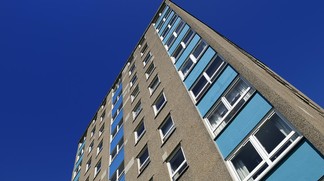Nov 5 2012
Is post-war industrial and pre-fab architecture worth preserving and renovating? To answer this question, EPFL architects conducted a three-year pioneering study into the restoration of modern buildings.
 Prefabricated building
Prefabricated building
Although there is fairly good consensus on the architectural quality of historical buildings, the issue of the historical value of modern buildings is much less clear cut. Prefabricated, or "pre-fab," buildings still have an undeniably negative image; they're thought of as flimsy, ugly, made from shoddy materials, with minimal acoustic and thermal insulation, and so on. "People who have lived in these buildings have a hard time being objective about them, they overwhelmingly see the downsides," explain Franz Graf Giulia Marino, architects from EPFL's Laboratory of Techniques and Preservation of Modern Architecture (TSAM). "Our role is to make a scientific assessment of that heritage."
The researchers, specialists in modern architectural heritage, have just wrapped up a three-year study on the issue of restoring recent architecture, in collaboration with the Accademia di architettura de Mendrisio, ETH Zurich and the University of Applied Sciences and Arts of Southern Switzerland.
Renovation is an architectural act
The post-war period ushered in the era of mass production — things needed to be rebuilt, and fast, without worrying about the constructions' technical shortcomings. Today things are built in a more complex manner — a responsible response to economic and environmental concerns. "Contrary to conventional wisdom, it is less expensive overall to renovate than to tear everything down and start over again," says Graf.
The researchers identified the fabrication methods used in European buildings from the 1920s to 1970s.
There's no ideal renovation method, says Marino. Every case is unique. "When you apply a one-size-fits-all solution, you destroy heritage." Schools built in the 1960s are a good example. They were built according to the standards of the time, but are now considered uncomfortable and energy inefficient. Renovating them becomes a true architectural project, one that respects the original work but also meets the requirements of the present day.
The concept of "comfort"
When renovating a contemporary building, many historical aspects and human needs, such as room temperature and lighting, must be taken into account. "What do we do when we restore? What kind of light source do we use? In 50 years we've used incandescent bulbs, halogen lights, fluorescent lighting and now LEDs." One kind of lighting cannot replace another without taking into consideration the quality and intensity of artificial lighting and the space that it must illuminate.
In terms of temperature, we've become accustomed to living in spaces heated to about 22¡æ. People wouldn't tolerate reverting to conditions that were considered normal just a few decades ago.
The concept of modern comfort in our homes can be traced to the improvement in the standard of living that began in the 1920s and 1930s. Central heating progressively replaced coal burning stoves. Electricity brought light into our living spaces.
For future generations
How can we preserve the ambience of an era, while also providing a level of comfort to which we've become accustomed today? There are rational methods that can be used to evaluate the quality of a building. The vast apartment complex of Lignon in Geneva, where 6,500 people live, is an example of industrialized architecture. This gigantic complex, the longest in Europe, was built in the 1960s and is a symbol of the baby boom era, the cities that expanded ever outward, the new suburban apartment blocks that sprung up at their edges. There are methods and techniques to adapt these constructions to current energy standards while preserving their overall architectural qualities.